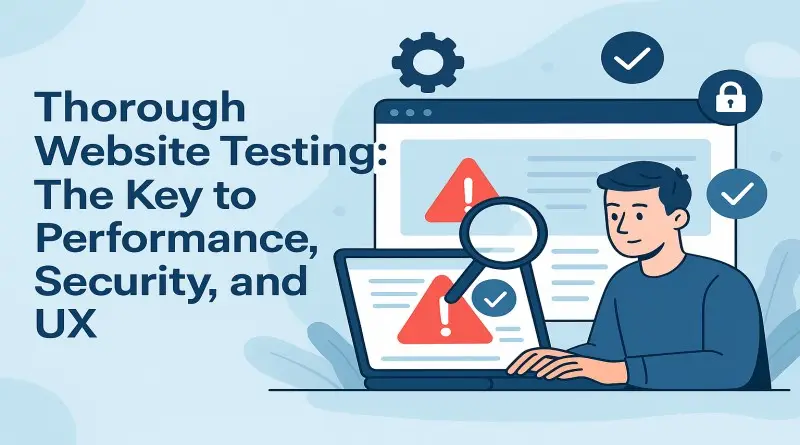Thorough Website Testing: The Key to Performance, Security, and UX
A company with a website in the current digital era is likely to get more customers since it is the first point of contact with the audience. The success of any site, be it an e-commerce site, a corporate site, or an educational site, depends on the level of the performance, security, and user experience (UX). Vigilant testing is constructed before launching; these factors converge so that an effective, consistent, and interactive experience is projected. In India, 90 percent of the persons who access the internet do so using smartphones (IAMAI, 2024), and it is crucial to conduct rigorous tests to satisfy different user requirements and achieve competitiveness. This article discusses why thorough testing of websites is important, including major categories of testing, its advantages, and some specific information that is relevant in the Indian digital environment and adds value to AdSense as well as the readers.
Why Website Testing Matters
A site is not just a facade of a shop in virtual reality; its credibility is depicted as the brand image of a company. One stuck connection, a page that loads too slowly, or even a security breach may make the client leave, as 53% of the visitors also leave the sites that require over three seconds to load (Google, 2024). In India, with an estimated 300 billion dollars of sales to come by 2030 (NASSCOM, 2024), poorly running sites stand to lose their potential income and damage credibility. Test sites and speed up results, secure them, and make them user-friendly, which will carry a direct consequence on user retention, conversion, and ranking by search engines. In terms of Indian firms, 75 percent of SMEs mainly use digital channels to grow (FICCI, 2024), so in order to cut through the market, it is a no-concession practice necessary to test the products or services before providing them to the market.
Key Testing Types for a Robust Website
Comprehensive website testing covers multiple dimensions to address functionality, accessibility, and security. Below are the critical areas to prioritize before going live, tailored to India’s mobile-first and diverse user base.
1. Usability Testing: Ensuring Intuitive Navigation
Usability testing is the method to test the accessibility of the site in terms of finding services and accessing other functions such as filling in forms. It is essential to design intuitively to reach many different groups of people in India, where 60 percent of those using the internet favor using regional languages (IAMAI, 2024). Testing is done by simulating journey routes, acquiring feedback, and refining layouts in order to remove friction. As an example, it is essential to have call-to-action (CTA) buttons and a mobile-friendly navigation system because 80 percent of Indian internet users access websites using low-end smartphones with different sizes (TRAI, 2024). A UX that has survived testing can raise conversion rates up to 30 percent, as is the case in optimized e-commerce sites (McKinsey, 2024).

2. Browser Compatibility Testing: Consistency Across Platforms
Since users browse through websites using browsers such as Chrome, Safari, and Samsung Internet, compatibility testing will guarantee uniformity when it comes to functionality and appearance. Testing on mobile web browsers is essential to functioning in India, where Android has an 85 percent market share (Statista, 2024). This will include layout checks, scripts, and responsiveness across devices and screen sizes. HTML/CSS that complies with the standard and does not use browser-specific code will avoid the problem of a broken layout that will prompt a user not to visit the site again, discouraging 65 percent of the population (Google, 2024). The cloud-based tools will be able to emulate real-life situations and thus will be widely compatible.
3. Performance Testing: Speed as a Competitive Edge
The speed of websites is quite a game changer, more so in the mobile-first market in India, with poor networks prevailing in Tier-2 and Tier-3 cities. Performance testing tracks load times, the size of the images, and the response of the server. The idea is to load a page with a size less than 2 MB and load it in less than 2 seconds. Asset refinements, the amount of content delivery networks (CDNs), and lazy-loading images can improve the bounce rate by 20 percent (Google PageSpeed Insights, 2024). The faster load times on Indian e-commerce websites are positively correlated with 25 percent higher conversions, which makes performance testing a cash flow generator (McKinsey, 2024).
4. Security Testing: Protecting User Trust
Hacks have the potential to kill most websites, particularly in regard to 92 percent of businesses having ransomware as a leading priority (Zscaler ThreatLabz, 2025). Security testing is important in India; the latest report by NCRB suggests that cybercrime costs in India will exceed 15 billion in 2024. This also involved checking SSL, cleaning of form data, and scanning for vulnerabilities such as cross-site scripting. The use of HTTPS and CAPTCHA on forms secures the data of their users and allows them to conduct their operations in accordance with the Indian IT Act quickly due to the regular scans, which makes people trustful in them.
5. Accessibility Testing: Inclusive Design for All
Accessibility makes websites functional among people with disabilities by following Web Content Accessibility Guidelines (WCAG). In India, 2.68 percent of the population has disabilities (Census 2011); accessibility testing allows making websites more inclusive and boosting their SEO. This includes the color contrast check, navigation using the keyboard, and compatibility with the screen reader. Semantic HTML and ARIA tags make the access wide, whereas the use of appropriate headings and alt text positively affects the search result rank, as Google ranks accessible websites (Google, 2024).
SEO and Business Benefits
Testing contributes directly to SEO through speed, usability, and accessibility, major attributes of Google’s ranking algorithm. An organic backlink is drawn in by an excellent examination site, and 70 percent of the well-performing websites are mentioned to have strong testing opportunities (Ahrefs, 2024). It instills user trust that lowers bouncing from sites and enhances recurrent visits, a factor that is appreciated in the form of better ranking by Google. To the Indian business, they mostly depend on organic search for leads: up to 80 percent of small and medium enterprises (SMEs) conduct business this way (FICCI, 2024). Testing helps to ensure that forms and CTAs are operational, which generate inquiries and conversions.
Local Context: India’s Digital Imperative
The Indian digital economy, which is poised to reach $1 trillion by the year 2030 (RBI, 2024), requires websites that serve different users. To test regional language support, mobile compatibility, and compatibility in low bandwidth, the most important aspect is to test it to ensure that half of the people using the internet are on 4G or slower internet in the rural setting (TRAI, 2024). It is also very crucial in terms of security, and 81 percent of Indian companies use zero trust approaches to fight VPN risks (Zscaler ThreatLabz, 2025). Taking cognizance of these local requirements, testing creates waves with the 600 million web-based consumers that are in India.
Unique Insights: Beyond the Basics
Testing is not necessarily solely concerned with bug-fixing; instead, it is the future-proofing issue. As an example, compatibility with the use of dark mode is catering to the needs of young and highly technologically advanced Indian users, whereas Google Translate integration checks are the requirements of multilingual consumption. Optimizing crawlability by checking sitemap.xml and robots.txt files is important in India to cope with the competitive SEO environment in India. Also, the custom 404 pages testing and scroll-to-top elements will improve UX and will not cause frustration in case of using mobile devices.
Why It Matters
Thorough website testing is the backbone of a successful online presence. It ensures speed, security, and accessibility, driving user trust and business growth. In India’s fast-evolving digital market, where competition is fierce and user expectations are high, testing is a strategic investment. By delivering a polished, reliable website, businesses can capture leads, boost SEO, and build lasting credibility, setting the stage for long-term success.
Disclaimer
The information presented in this blog is derived from publicly available sources for general use, including any cited references. While we strive to mention credible sources whenever possible, Web Techneeq – Website Development Company in Mumbai does not guarantee the accuracy of the information provided in any way. This article is intended solely for general informational purposes. It should be understood that it does not constitute legal advice and does not aim to serve as such. If any individual(s) make decisions based on the information in this article without verifying the facts, we explicitly reject any liability that may arise as a result. We recommend that readers seek separate guidance regarding any specific information provided here.

